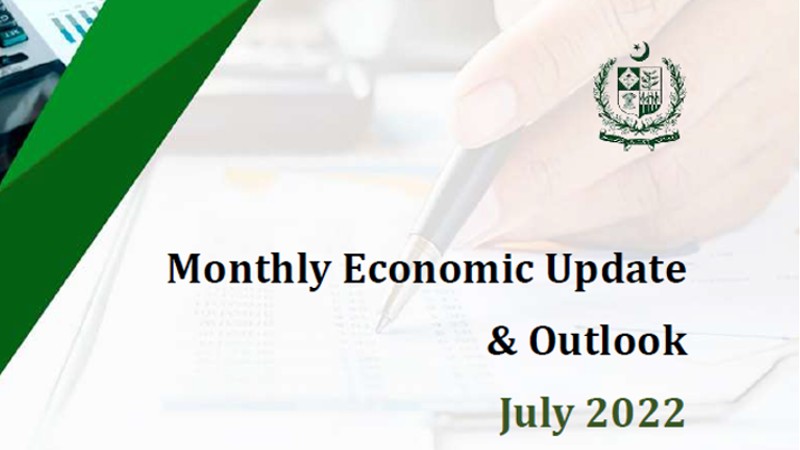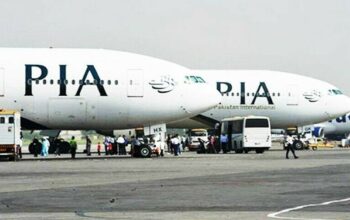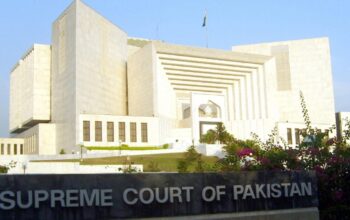Inflationary and external sector risks – along with “political unrest” – are contributing to an uncertain economic outlook, says the July Monthly Economic Update & Outlook.
By Staff Reporter
ISLAMABAD: The Ministry for Finance said Thursday Pakistan’s economic outlook was uncertain, and chalked this and the ongoing slide of the rupee and consistently high inflation up to the “political unrest” prevailing in the country – along with macroeconomic imbalances caused by inflationary and external sector risks.
Prime Minister Shehbaz Sharif’s government is under a withering attack from former Prime Minister Imran Khan and his allies.
Sharif rose to power this April after his 11-party Pakistan Democratic Movement (PDM) coalition ousted Khan in a parliamentary vote of no confidence.
In its Monthly Economic Update & Outlook report for July, the Ministry highlighted risks to Pakistan’s economy including the persistence of higher inflation, depleting foreign currency reserves, and an economic slowdown.
“The government has taken all difficult decisions to make reviews successful, reaching a staff-level agreement for a USD 1.17 billion loan tranche”, says the report.
“However, ongoing political unrest is not only creating governance problems but on the other hand, intensifying the uncertainties depicted by exchange rate depreciation which will, in turn, impact the cost of production. Halting investment decisions is further making the outlook blurry”.
The report confirms YoY inflation has accelerated by more than 20 percent and may continue to remain high in the immediate short run.
The reported concedes Pakistan’s forex reserves have fallen below international standards. Explaining slide of the rupee, the report identifies depletion of foreign currency reserves because of the widening current account deficit as the key culprit.
The report notes domestic activity continues to be strong despite the gradual decline in the economic growth outlook in Pakistan’s main export areas.
It states that these factors have contributed to significant upward pressure on domestic interest rates and the State Bank of Pakistan (SBP) had to raise its policy rate. Furthermore, significant fiscal consolidation is in the making.
These developments may put downward pressure on domestic demand and risk slowing down economic growth in the short run.
The report says high international prices are still adversely affecting external positions even in the start of FY 2023.
“On the other hand, long-term economic policies should see through these short-term headwinds”, says the report. “Once the tranche from IMF is received, additional financing channels will open themselves. This should allow focusing on longer-term objectives.”
One of the longer-term objectives is to secure a high sustainable growth trajectory adequate to absorb Pakistan’s rapidly growing human capital while avoiding internal and external financing constraints. “To avoid these constraints, effective supply-side dynamics must be combined with prudent demand management”.
On the external front, the report says amid the international scenario, exports of goods and services show a positive trend as per BOP data.
However, a strong surge in international commodity prices also inflated the import bill, widening the trade deficit.
FDI posted a growth of almost 92 percent in month of June 2022, but over the whole fiscal year, financial account could not grow enough to offset the current account deficit, which in turn contributed to depletion of forex reserves.
“With all these factors, along with political uncertainties, the market-based exchange rate significantly depreciated especially in the first twenty days of FY 2023”, says the report.
The report however, expresses optimism that with the government’s “appropriate policies”, imports will fall further, which combined with the continued decent performance of exports of goods and services and workers remittances will bring current account deficit down to a manageable level.
Citing BOP data, the report says the trade deficit in goods and services was recorded at USD 4.6 billion in June 2022. It voices optimism that trade balance will revert to lower levels in July 2022, and remittances will continue to remain strong.
Imports of goods and services are expected to come down from exceptionally high levels observed in May and June. Taking these factors into account, as well as its other components, the current account deficit is expected to steadily decline in the coming months.
For July 2022, based on low import growth and better performance of both exports and workers’ remittances, a significant decline in the current account deficit is anticipated.
On the fiscal side, the expansionary fiscal policy stance throughout FY2022 widened the fiscal deficit by 58 percent during Jul-May FY2022. In terms of GDP, it increased by 5.2 percent in Jul-May FY2022 against 3.9 percent last year.
“The fiscal consolidation efforts were severely hampered during FY2022 owing to the relief measures introduced to offset the impact of higher energy and commodity prices. Resultantly, the expenditure side came under significant pressure and thus limited the already constrained fiscal space for growth oriented and social development programs.
“On the revenue side, despite difficult economic conditions, tax collection surpassed the Rs 6.0 trillion mark in FY2022. Due to broad-based growth in all revenue heads, net tax collection increased by 29 percent in FY2022 over the preceding year.
“Direct taxes, in particular, increased by 31 percent, which is consistent with the government’s policy of enforcing taxation on earned income, thereby reducing the indirect incidence of taxation.
“During the year FBR introduced various initiatives, however, the POS system to document the retail sector and the TTS to capture LSM across the country played a significant role in improving tax collection. For FY2023, tax collection is budgeted at Rs 7,470 billion.
“To maintain the growth momentum and to achieve the set target during the current fiscal year, reform measures would continue to focus on facilitating taxpayers to create a congenial environment, using technology to improve documentation, and broadening the tax base, etc.
“During the first eleven months of FY2022, expenditure overrun the revenue growth, and thus fiscal deficit is revised upward. It is likely to remain at 7.1 percent of GDP.”
The complete report may be read below.
Copyright © 2021 Independent Pakistan | All rights reserved




